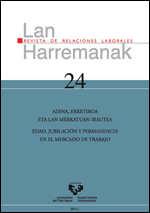Envejecimiento y prevención de riesgos laborales
##plugins.themes.bootstrap3.article.main##
##plugins.themes.bootstrap3.article.sidebar##
Abstract
In this work we try to reflect on the influence of workers' ageing on the prevention of risks at work. The article starts by pinpointing the demographic context and the relationship existing between ageing and the generation of risks at work.
We then go on to deal with the first manifestation of this in the form of reactive, non-preventive regulations, the influence of riskiness and the excessively arduous nature of certain activities; the reduction in ordinary retirement age pursuant to section 161 bis of the General Law governing Social Security (LGSS).
Lastly, we analyse the expressly preventive regulations that can govern ageing both on an international and internal level, in this case via the regulation of sensitive workers in accordance with section 25.1 of the Law governing Risks at Work (LPRL). And we finish by referring to the possibilities for collective bargaining on this issue.
How to Cite
##plugins.themes.bootstrap3.article.details##
Authors who publish in the journal "Lan Harremanak" do so in agreement with the following terms:
1. Authors retain the copyright of their papers. while ceding to the journal "Lan Harremanak" the right to the first publication of their article.
2. The publisher UPV/EHU Press is a joint copyright holder, in order to protect the legitimate use of the published paper and compliance with CC terms.
3. Published papers are subject to a Creative Commons CC-BY license (unless stated otherwise) which permits third parties to share the paper, on the condition that the author and source are specified when material is reproduced.
4. Authors can enter into other non-exclusive license agreements regarding the published version of their work (e.g. depositing it in an institutional repository or re-publishing it as a monographic volume), providing the author and source are given appropriate credit.
5. Dissemination of submitted articles via Internet is both allowed and recommended (e.g. in institutional repositories and/or on the researcher's web page), both before and during the process of submission, since this can lead to interesting dialogues and also increase citations to the eventual publication.

